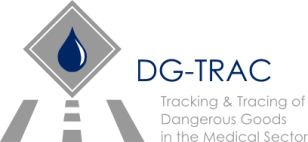
Objectives of the service
The key issue with the dangerous goods’ transports in the medical sector is that they are often not carried out according to the legal requirements. In the area of medical goods transport even very small quantities of a dangerous good can be very dangerous (i.e. samples with infectious blood containing viruses).
Another key issue is that civil authorities have no overview or situational knowledge of particular dangerous goods transports. In case of an alert they do not know the nature and characteristics of the transported goods and therefore are unable to take risk-reducing or preventive measures.
The DG-Trac demonstration project implements a user driven service for tracking and tracing dangerous goods in the medical sector.
It offers:
- Continuous real-time tracking of the dangerous good from the sender to the receiver
- Provision of all necessary information how to handle dangerous goods
- Check of the certifications of all involved persons
- Secured Hand-over (with legally proven electronic signatures)
- Creation of all necessary transport documentation in electronic form or for printing and a final reporting
- Access to transport information for public safety services in case of an incident
- Conformance to data privacy and security rules
- Interfaces for public safety services (eCall support)
Users and their needs
Target users of the DG-Trac service are
- Hospitals, Laboratories
Due to the centralisation in the medical sector more and more hospitals send their samples and used surgical instruments to central laboratories or central sterilisation services. - Pharmaceutical industry
The pharmaceutical industry is sending every day thousands of dangerous substances and samples to medical users - Public safety service
in case of an accident they need immediate information about the accident, the type of dangerous good and handling instructions to reduce the time needed.
The main user needs are:
- need to ensure that all rules for dangerous goods transports are followed by the driver and the receiver of the transport.
- need to report every step of the transport and to check if the driver of the transport and the receiver have been trained and have the correct certificates.
- need to track every container containing surgical instruments.
- need to track every blood sample on its way to the laboratory.
- need to have a real-time tracking of the transport and to know if the transport is still en route or already arrived at the receiver.
- The emergency services need to receive in case of an accident information about the dangerous goods loaded into the vehicle.
The project is supported by the following users:
- Abbott, Wiesbaden - one of the largest global healthcare companies. Abbott Wiesbaden is home to the largest research site for business unit diagnostics outside the US.
- Hôpitaux Robert Schuman, Luxembourg - a hospital network created in Luxembourg in 2014 with over 2200 employees
The countries target at the beginning are Luxembourg and Germany. An extension to overall Europe is foreseen for a later stage.
Service/ system concept
Tracking and tracing of transports already exist in many varied forms throughout Europe and it is recognised that dangerous goods transports are special cases.
However the medical sector has shown itself to be very different from what has been traditionally classified as dangerous goods transport until now. It has very specialised requirements for its handling throughout the entire transport cycle.
The challenge and risk lies in being able to track the goods efficiently and to ensure that all transports are carried out according to the legal rules.
Sensors are used to track the environmental conditions of the containers (i.e. temperature, humidity).
The DG-Trac service tracks the location of every dangerous good transported; guides the users through the processes with an easy to use application; and records every step of the process. In the case of an incident, the emergency services can use this service to check if a transport being involved in the incident contains dangerous goods. DG-Trac service will be integrated with the upcoming European eCall system which will alert the public safety service automatically in case of an accident. In this case the DG-Trac service will provide the information about the loaded dangerous goods to the public safety services automatically.
Space Added Value
The DG-Trac system will integrate two different space assets in running the complete service:
- A satellite navigation service, relying on Global Navigation Systems (GNSS). The navigation service will allow the transport vehicle to receive its current geographical position continuously, and forward it to the system. This will allow real-time tracking and tracing services.
- A satellite Bi-directional communication service. The service will allow suitably equipped emergency services to receive information about dangerous goods and any eventual alerts that are raised (in case of an incident) in near real-time.
Current Status
After the successful execution of the feasibility study the demonstration project started in December 2014.
The project team worked with two pilot users Abbott and Hôpitaux Robert Schuman.
In July 2016 the DG-TRAC HW was installed at the user’s premises and in the user transporters. In September 2016 the demonstration phase started. In total over 350 transports were successfully executed.
The demonstration phase ended successfully in August 2017.




